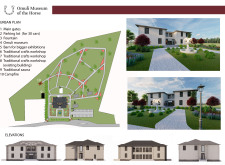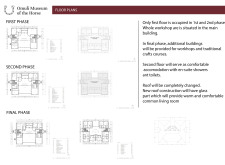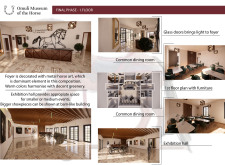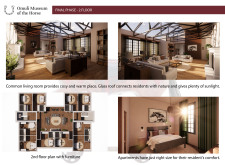5 key facts about this project
The Omuli Museum of the Horse is situated in a region known for its equestrian heritage. It functions as a cultural hub that promotes education and community involvement through various exhibitions and workshops. The design blends practical spaces with a focus on traditional craftsmanship, inviting visitors to engage with the history and artistry of horse culture.
Urban Planning and Accessibility
The urban layout emphasizes accessibility with main gates and a parking lot designed to accommodate 30 vehicles. This arrangement allows easy access for visitors while keeping surrounding areas less congested. A central fountain acts as a visual point of interest at the entrance, offering a soothing atmosphere as people arrive at the museum.
Architectural Form and Materiality
Architectural elevations suggest a design that harmonizes with its natural surroundings. Metal art installations in the foyer highlight the equestrian theme, connecting the building to its cultural context. The design effectively balances modern architectural elements with more traditional motifs, creating an environment that is both informative and engaging for visitors.
Functional Layout and Phased Development
The floor plan is divided into three phases to allow for a gradual implementation of various functions. In the first phase, the ground floor is dedicated to workshops that promote hands-on learning experiences. The second phase introduces additional buildings focused on workshops and educational courses, further enhancing the museum's offerings. Accommodations on the second floor include en-suite bathrooms designed for guest comfort.
Community Engagement Spaces
Social areas are a key focus, with features such as a dining room and a common living room that encourage interaction among visitors and residents. The common living room includes a glass roof, allowing natural light to flood the space and create a sense of connection with the outside. These communal elements are thoughtfully integrated into the overall design, promoting community spirit and cultural exchange.






















































